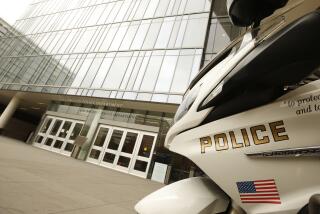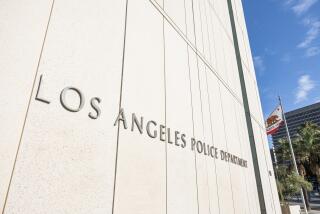Police, Prosecutors Uneasy Partners in Simpson Case : Law enforcement: Longstanding tensions have been aggravated. News leaks, evidence handling are sore points.
- Share via
As partners in one of the most closely scrutinized murder trials of all time, the Los Angeles Police Department and the district attorney’s office share a mission: finding and convicting the killer of Nicole Brown Simpson and Ronald Lyle Goldman.
But as they tackle the historic case, sources in and around both agencies say Los Angeles’ largest law enforcement institutions are moving in opposition as well as in conjunction, blaming each other for leaks, failing to communicate about evidence and even at times undermining each other’s efforts.
In recent days, some police officers have grumbled about the performance of Deputy Dist. Atty. Marcia Clark, Police Chief Willie L. Williams has appeared on television and reopened a dispute about which agency is to blame for the release of controversial 911 tapes, and detectives have complained that prosecutors failed to back them in the face of a defense request for samples of their hair.
Such disputes are just the latest to arise since June 13, when the bodies of Nicole Simpson and Goldman were found slashed and stabbed to death outside her Brentwood townhouse.
Top officials at each agency concede that there have been some differences but say the working relationship between the LAPD and the district attorney’s office is fundamentally solid. Williams and his top staff have praised prosecutors, and Dist. Atty. Gil Garcetti has likewise offered public compliments about the LAPD.
“Certainly, there’s going to be times when you don’t like something that someone may say,” Williams said in an interview Friday. But “the overall relationship between the district attorney’s (office) and the LAPD is very, very sound.”
Garcetti agreed. “Anytime there’s a long, protracted situation, there’s going to be issues,” he said. “I think we have probably the best working professional relationship that we have ever had.”
Nevertheless, the Simpson case has triggered a series of pointed disagreements--perhaps the most serious of which involve news reports.
At the district attorney’s office, sources say prosecutors blame police for putting out an erroneous report about DNA test results, which some believe was leaked to retaliate for a tongue-lashing that a police detective took from Superior Court Judge Lance A. Ito that same day; at Parker Center, meanwhile, some police believe that the district attorney’s office leaked the same story in an effort to bolster its motion to sequester the jury. Both agencies deny any wrongdoing.
Other disputes have erupted over the way detectives conducted searches in their quest to build a case against O.J. Simpson, who has proclaimed his innocence in the face of charges that he committed the double homicide. And despite their public proclamations, high-level officials from the two agencies and the city attorney’s office continue to dispute how the tapes of dramatic 911 calls placed by Nicole Simpson in 1989 managed to be publicly released.
The slip-ups and finger-pointing in the Simpson case are far from the first time that the LAPD and district attorney’s office have been at odds. In fact, the relationship is rife with discord, and several recent cases have deepened the animosity: Many police officers were furious at prosecutors’ refusal to bring charges against entertainer Michael Jackson; others were angry about a prolonged and aggressive investigation of a police shooting that left a woman dead atop a hospital.
“There’s always been tension in the relationship, and given a case like this where everyone is watching, it’s only gotten worse,” said former Dist. Atty. Ira Reiner, who blames the LAPD for most of the tension. “Historically, the LAPD has not really been up to the standards that the D.A. would like.”
Police vehemently reject that characterization and tend to belittle the district attorney’s office as a political creature, contrasting that with their perception of the LAPD as a professional institution largely immune to the whims of public opinion.
The combination of historical tensions and new feuding means that a sometimes divided law enforcement team has been handed the challenge of defeating Simpson’s battery of investigators and lawyers. Eager to sow discord and to uncover the sources of news reports, Simpson’s lawyers have wasted few chances to encourage mistrust among their adversaries, calling for the attorney general to investigate leaks and suggesting that police cannot be trusted.
Johnnie L. Cochran Jr., one of Simpson’s lead attorneys, said his side is not averse to raising issues that divide the opposition. “In our position, sometimes you have to be confrontational,” Cochran said. “You have to put the other side on the defensive.”
Williams acknowledged that the defense efforts have produced some results. “I think some of the differences have been exacerbated by the defense team,” the chief said. “They have half a dozen of the best defense attorneys in the country. . . . The defense team is doing a very skillful and in some respects successful job of exploiting the differences.”
Robert L. Shapiro, Simpson’s other lead lawyer, declined to venture a guess about the inner workings of the police and prosecution teams, but he crowed about a recent appearance by Williams on a talk show where the 911 tapes were discussed.
On one of the tapes, Nicole Simpson sobs as a man she identifies as her ex-husband shouts angrily in the background.
Garcetti had previously blamed the Police Department and the city attorney for making public the explosive tapes, which he said were released without his knowledge.
Williams, however, cast the release in a far different light, suggesting that the prosecutorial agencies favored making the tapes public while police were trying to exercise restraint. In an interview last week, Williams said he had expressed reservations about making public the 911 tape but that officials from the city attorney’s office and from the district attorney’s office “felt that it was appropriate to release” them in response to media requests for the information.
“The chief of police came out and basically called Garcetti a liar,” Shapiro said of Williams’ remarks. “That certainly suggests some disagreements.”
The squabbling over how the tape was released remains a sore point between the agencies, and Williams said he believes better protocols may be needed to clarify departmental responsibilities in high-profile cases such as the Simpson investigation. Although the top brass of the agencies are working to smooth over differences, potentially serious miscommunications in the Simpson case have occurred over the collection and testing of evidence.
During a hearing last month, government lawyers were stunned when a package was opened in court and they learned for the first time of a note from Nicole Simpson to her ex-husband.
The officer who seized the note said he had taken it because he believed it may have hinted at a possible motive for O.J. Simpson to have committed the murders. But the letter’s impact on the prosecution case was ambiguous at best, and government attorneys were forced to publicly admit that they had never before seen the document. Although prosecutor Clark tried to downplay the importance of that new evidence, law enforcement sources say members of the district attorney’s office were furious to learn of the note’s contents months after it was seized.
Other mistakes have surrounded blood samples: Scores were collected, and prosecutors were forced to concede at one point that samples had been sent to a lab by the LAPD without their knowledge. Although Ito found that no subterfuge was intended, the judge icily described the efforts of police and prosecutors as “a picture of confusion, miscommunication and non-communication.”
Some gripes are more personal. Within the LAPD, some officers make sexist comments about Clark’s temperament and say that she is not the right person to handle such an important case.
“She flies off the handle,” one police officer said. “That’s a problem they have in that office with the women prosecutors.”
Clark has consistently declined to discuss the case outside court. She did not respond to a request for comment Friday.
For their part, some prosecutors see LAPD detectives as sloppy investigators whose work has deteriorated in recent years in the face of cutbacks and plummeting Police Department morale. Others like and respect their LAPD counterparts but nevertheless complain about the quality of work that the department is producing.
“The quality and crime-fighting relevance of felonies submitted to us for filing has substantially decreased,” Donald N. Eastman, a high-ranking official in the office, wrote in a memo to Garcetti last year. “Our line lawyers feel that LAPD officers are compelled by current circumstances to go through the motions, push paper, work their shift and go home.”
Such complaints, Reiner said, are nothing new: “The expression that has been used for years in the D.A.’s office to describe the LAPD is: ‘Just enough is enough.’ ”
It is that attitude, say sources close to the Simpson case, that has helped contribute to some of the Police Department’s miscues. Among others, the failure to log the contents of the Nicole Simpson note and the careless safeguarding of Simpson’s Ford Bronco while it was in police custody have irritated prosecutors.
Although personality conflicts, longstanding animosities and confusion about evidence have contributed to the unease between the agencies in the Simpson case, it is the continuing stream of leaks that has most bitterly divided the two organizations.
From the opening days of the investigation, police and prosecutors have blamed each other for numerous news reports.
Early on in the case, The Times and some other news organizations carried reports disclosing that a pair of bloody gloves--one at Simpson’s home and one at the murder scene--had been recovered. Law enforcement sources provided that information, and Simpson’s lawyer at the time, Howard Weitzman, denied it up until the day he left the case. That report later was borne out in testimony.
Other reports disclosed that blood drops from the scene matched some of the characteristics of Simpson’s blood; the first stories dealt with conventional blood analysis, and subsequent articles have detailed far more sophisticated DNA test results. Other stories revealed that Simpson had cuts and scratches when interviewed by police, that an off-duty Los Angeles police sergeant provided security for Simpson while he was under investigation, and that a hair recovered from Goldman’s body resembles hair samples taken from Simpson.
Although both sides have complained that the information in those reports was improperly released, neither police nor prosecutors nor defense attorneys have challenged the veracity of any of those stories--all of which were reported first by The Times.
In recent weeks, however, feuding over leaks has gained intensity because of television reports that inaccurately portrayed the status of scientific testing in the case. Those stories, which were aired first by KNBC Channel 4 and were echoed by CNN, reported that DNA tests of blood on a pair of socks discovered in Simpson’s bedroom genetically matched Nicole Simpson’s blood.
During court discussions about those reports, defense attorneys and prosecutors formed an unusual alliance and requested an investigation to ferret out the source of the leaks. Denying all responsibility themselves, the attorneys together attacked the LAPD as the likely source of the erroneous disclosures. Cochran called for the LAPD to launch an Internal Affairs investigation, and, in a rare point of agreement with her adversary, Clark seconded that notion.
For police officers, it was one thing to be attacked by the Simpson defense team, but quite another to have the district attorney’s office join in.
“How nice for them,” one police officer said sarcastically. “All the lawyers get together and decide that none of them said anything. The one thing they all agree on is that we get blamed.”
Veteran court watchers, even those sensitive to the long rivalry between police and prosecutors, were surprised to see Clark so directly blame the police.
“It’s pretty undiplomatic to dump it on the Police Department,” said Harland W. Braun, a noted criminal defense lawyer and former deputy district attorney. “I can see why it burns them.”
Reiner agreed. “The LAPD has a legitimate beef on this one,” he said. “The D.A.’s office is a big office, with lawyers, investigators, secretaries. . . . Anybody who would bet $2 that this information didn’t come out of the D.A.’s office is just a gambler.”
The LAPD has initiated an internal investigation to determine whether one of its officers was the source of that report. Prosecutors have not launched any comparable inquiry, but the defense has recently stepped up the pressure, trying again to drive a wedge between police and prosecutors.
In a motion filed under seal last week, Simpson’s lawyers asked for a hearing to search for the source of that report and possibly others. No matter what the outcome, the mere challenge may help further divide their adversaries.
“If that’s the case,” Cochran said, “so be it.”
More to Read
Sign up for Essential California
The most important California stories and recommendations in your inbox every morning.
You may occasionally receive promotional content from the Los Angeles Times.











